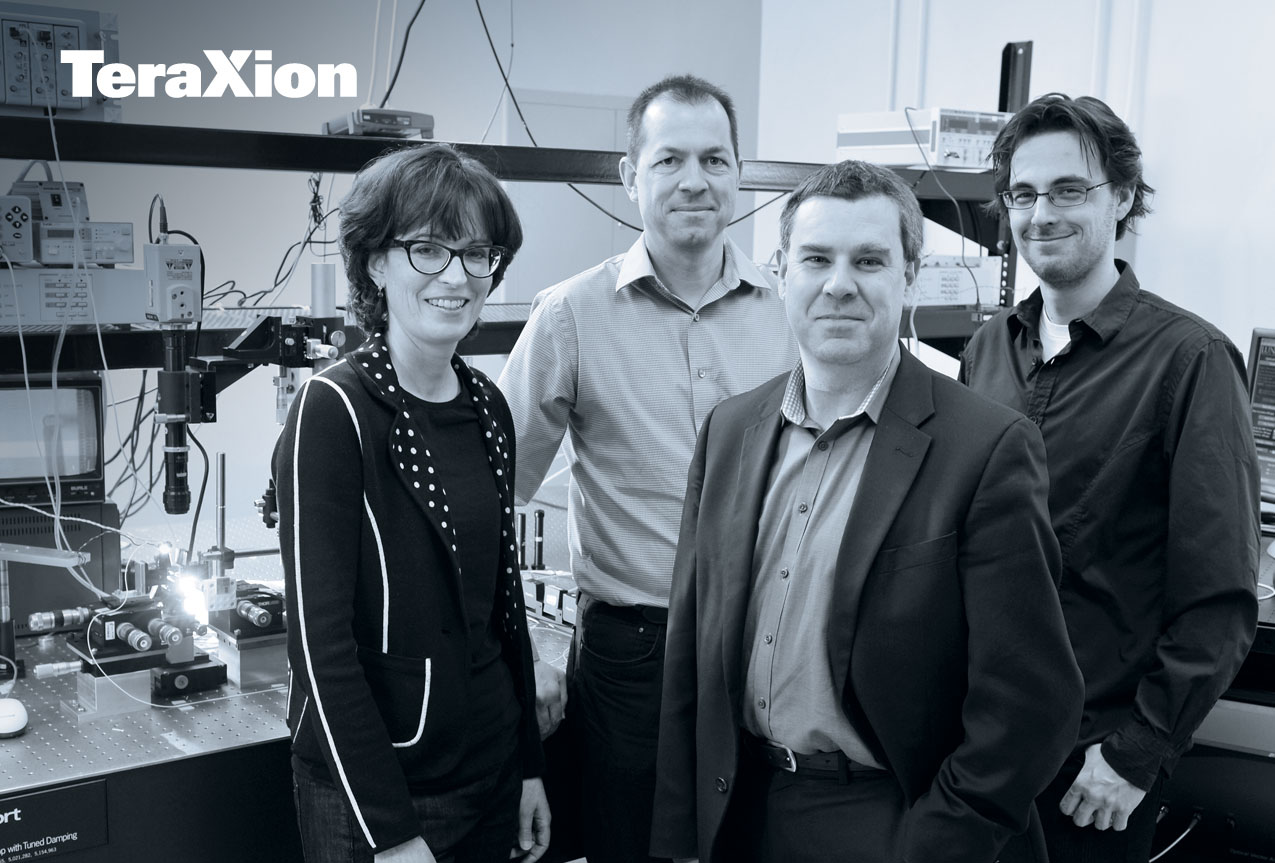The Need for Speed: Combining Light and Silicon to Harness the Power of Optical Networks

(Left to right): Dr. Sophie Larochelle, Université Laval; Yves Painchaud, TeraXion; Martin Guy, TeraXion; Alexandre D. Simard, Université Laval





TELECOMS | OPTICS-PHOTONICS
A Prompt-Supported Team Puts Photonic Innovation to Work


In our data-driven world, we have an increasing need for speed. With an ever expanding array of technologies that connect us to people, places and things almost anywhere, anytime, there is a global race to transmit more information faster than ever before.
In 2011, South Korea established the world’s fastest Internet connection, transmitting data directly to hundreds of homes over an ultra-high bandwidth network at one gigabit per second – about 100 times faster than the average Internet connection found in North America. In July 2012, Google launched an ultra-fast Internet service in Kansas City that offers ‘instant downloads, crystal clear high definition TV and endless possibilities’. According to the multinational giant, this initial installation of Google Fibre will serve as a pilot test for broader rollout to homes across the US – and explore new ways to push the technical boundaries of the Internet.
This capability is delivered by optical networks – an interconnected web of thin glass pipes or strands that use light to transmit large volumes of data very rapidly and reliably over long distances. TeraXion is developing technologies that improve the speed and capacity of these networks. As a global leader in the design and manufacture of optical components and modules, this Quebec-based company increases the capabilities of telecommunications companies, Internet providers and end-users. Over the last decade, the firm has sold more than 100,000 optical devices to 500 customers around the world – and this number is climbing. And according to Martin Guy, Vice President of R&D, research collaboration with Université Laval and Université de Sherbrooke enabled by Prompt provides the company with an undisputed innovation edge.
When TeraXion aimed to evolve its technology and strategic direction, the company engaged these Prompt-supported research partners to help deliver on its objectives. The firm sought to explore the possibilities presented by silicon photonics, an evolving technology in which data is transferred on a computer chip using light. It combines laser and silicon technology on the same chip to enable improved data processing speed, power and performance. The challenge: how best to capitalize on this complex technology in TeraXion’s next-generation products?
Leveraging funding and support from Prompt, TeraXion partnered with Dr. Sophie Larochelle, Canada Research in Fibre Optic Communications and Components at Université Laval on silicon photonics devices. “We conducted a series of experiments that enabled us to learn about the specific capabilities and limitations of this technology, and how to design, characterize and fabricate a working device,” said Dr. Larochelle. “We fabricated several initial prototypes through the Nanofab at the Université de Sherbrooke. This enabled us to test our theories, better understand the advantages of silicon photonics, and identify issues that impact data transmission speed, functionality and performance.”
According to Martin Guy, this project has paid significant dividends. “We are making a strategic investment in silicon photonics to further reduce the footprint, power consumption and cost of our products. Our collaboration with Université Laval, Université de Sherbrooke and Prompt enabled us to evaluate this technology in a highly productive way, and generate promising initial results. We are now applying the resulting knowledge to our next-generation technology platform to further increase the speed and capabilities of optical networks, and add greater value to our customers. This is important as we pursue new business in the industrial, aerospace, defence and public safety sectors.”
Mr. Guy underscores the critical role of Prompt on this project, and its contributions to the Information and Communications Technology (ICT) industry more broadly. “Prompt enabled us to expand our R&D capacity and leverage our R&D investment in silicon photonics. This funding helped us to reduce technical risk and accelerate the development of our next-generation technology. It also allowed us to hire several student interns from Université Laval, and provide them with hands-on experience with a commercial R&D team. This helps to cultivate the engineering talent required to increase the competitiveness of Quebec’s ICT sector. Prompt continues to work with us to actively explore new partnership opportunities.”

